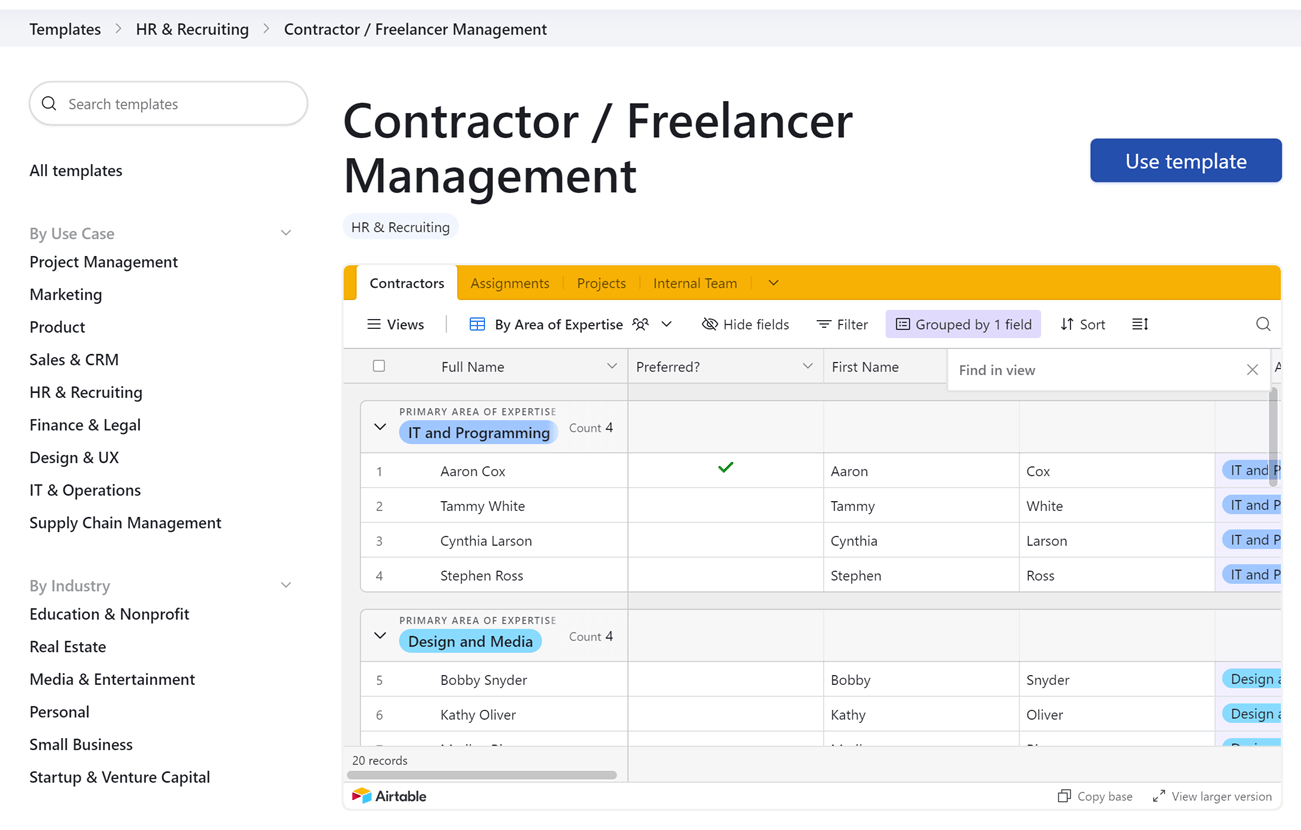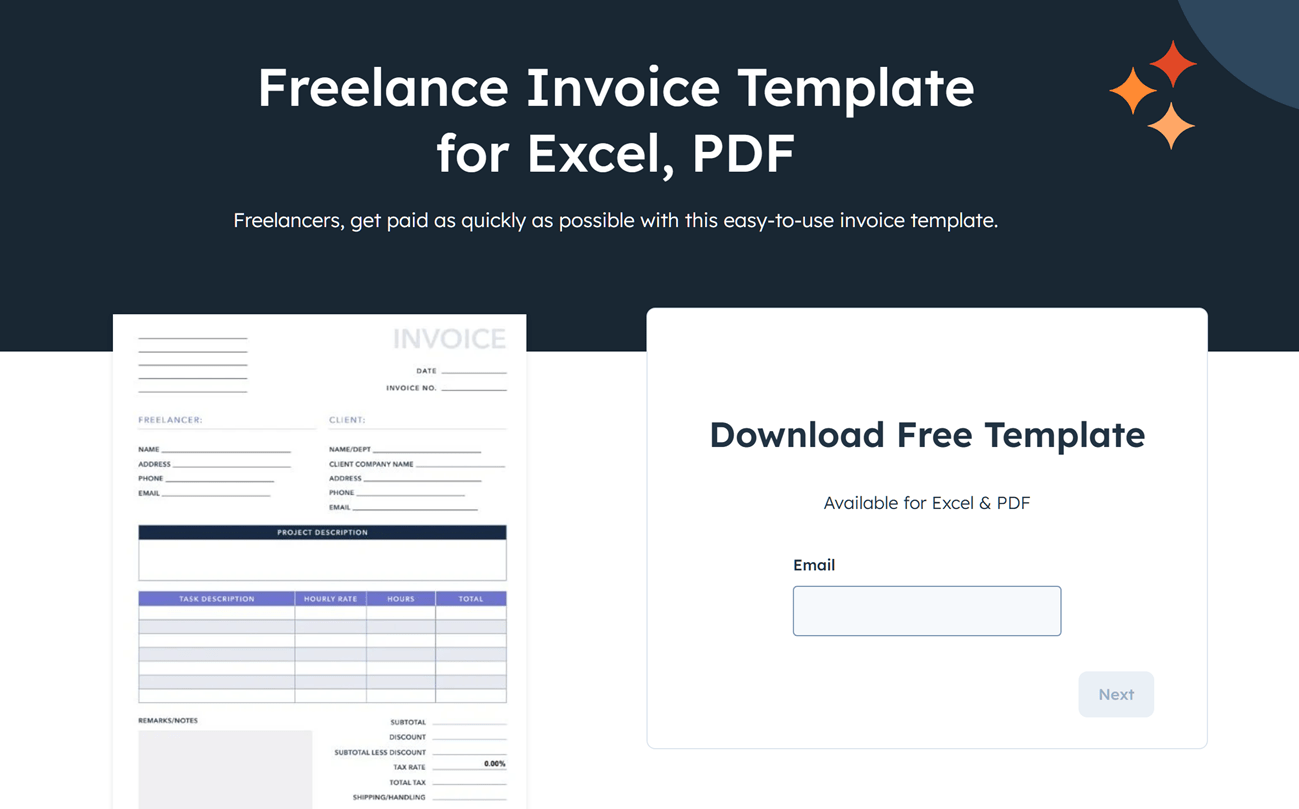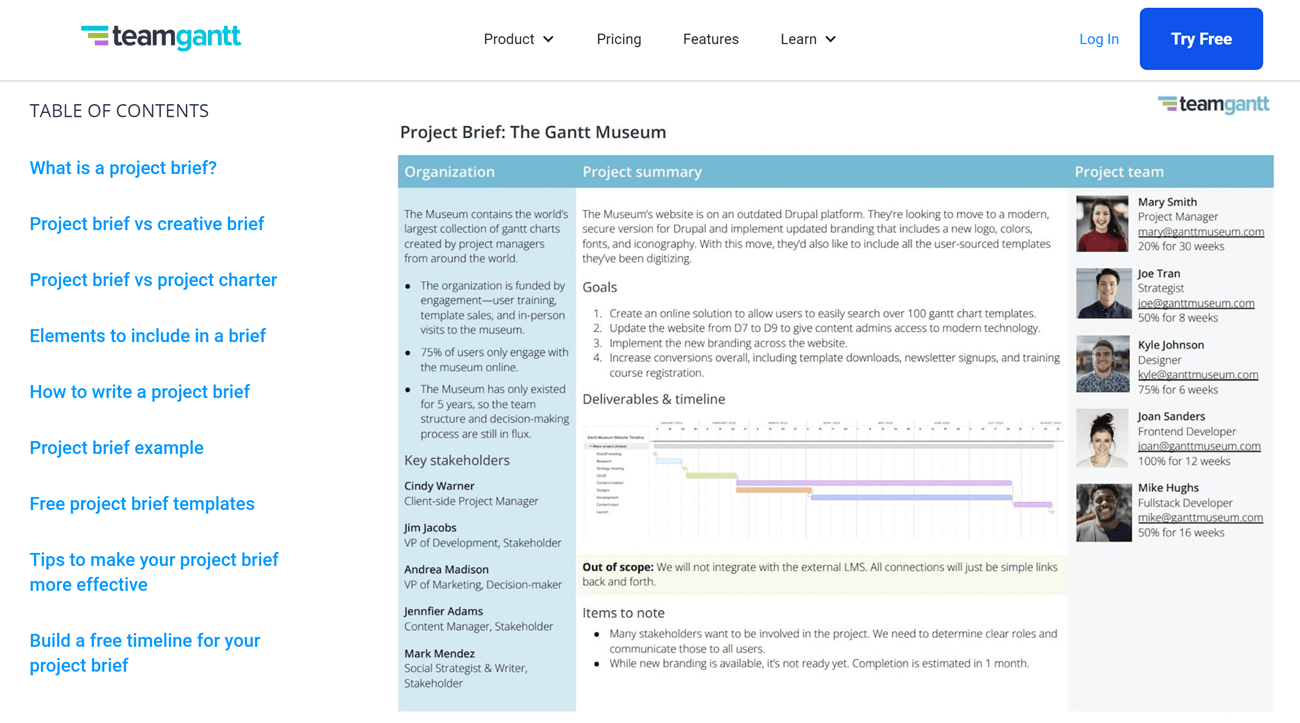Just about every business I’ve started has involved hiring freelancers. They’re more affordable and flexible, plus it’s easier to scale up or down as needed. One or two is easy, but things can get messy when you’re dealing with any more than that.
I’ve since built my own custom freelancer management system, I started with freelancer management templates. Here’s a curated list of my favorites.
monday.com: A powerful and flexible freelancer management template
Trusted by over 225,000+ businesses, monday.com is one of the most popular project management platforms out there. It’s perfect if you need an organized and flexible way to manage work for your in-house team, freelancers, agencies, and even other departments.
monday.com has a free plan for up to two users. It’s limited, but it is a good place to start if you want to try it out before paying.
More on monday.com: monday.com Review | monday.com vs Jira | monday.com vs. Notion.

To start, you’ll need to add all of your resources, including freelancers and in-house team members if you’re managing their work here too. From there, you can invite as many guest users as you need to at no extra cost.
Once they’re onboarded, you can start assigning tasks. They will be able to track their time, monitor deadlines, upload files, leave comments, and more.
The best part about this template is how it brings all of your outsourced tasks together. You’ll easily be able to keep track of everything happening outside the company in one place. Each task can have its own status, allocated amount of time, due date, owner, and assignee.
It’s simple, yet effective. You can also add additional columns if you need to.
monday.com makes it easy to control access and editing capabilities so you don’t have to worry about freelancers being able to see things you don’t want them to.
ClickUp: A Kanban-style freelancer management template
ClickUp is another powerful option if you want a complete project management solution.
Its generous free plan includes collaborative document sharing, whiteboard features, sprint management, calendar views, and Kanban boards. It’s more than enough to get started and many smaller businesses can stay on the free plan for quite some time.
You’ll be able to invite as many free users as you’d like, just keep in mind that you won’t have granular access controls unless you upgrade.
More on ClickUp: ClickUp Review | ClickUp vs Asana | ClickUp vs. Notion.

Kanban boards are simple, familiar, and highly visual — they’re great for managing projects and tasks, especially those you’re outsourcing to a contractor. They likely won’t have to learn a new system or wonder how it works.
All you have to do is create a backlog of tasks, assign them, set due dates, and invite them to collaborate with you on ClickUp.
They’ll be able to manage their work, mark tasks as complete, leave comments, ask questions, collaborate on documents, chat with you, and more.
It takes just a few minutes to configure everything if you’re using this template as is. Otherwise, it may take up to an hour to customize it to match your needs. You can adjust the columns, fields that show on each card, what it looks like when you open a card, and just about every other element.
You can even turn off features you aren’t going to use. This ensures nobody uses them by accident.
Knack: Manage projects, resumes, and invoices in one place
Knack is a no-code development platform that’s great for companies who want to create their own custom apps. You can use it to build web portals, databases, project trackers, and even a directory to manage all of your freelancers.
There’s no free plan, but there is a 14-day free trial if you want to try it before you invest. Plans start at $59 per month.
It’s a bit pricey, but it’s worth it if you need the level of customization it provides.

This template is great if you need a full system to manage freelancer projects and tasks, invoices, service agreements, and resumes.
It allows you to create a complete directory of every freelancer you’ve ever worked with. This can be useful if you want to have an approved list of contractors or a large pool of freelancers you can pick from at any time.
It’s also invaluable if you do a lot of recruiting or cycling through.
You’ll be able to categorize your directory based on their skills, experience level, type of agreement, or any other custom attribute you’d like. This makes it easy to find exactly what you need when you need it.
Contractors will be able to send invoices and even add a portfolio of their work directly within the platform. They have full access to their profiles and can update them any time.
The downside of this template is how much upfront work is required. You’ll likely have to do a bit of customizing, training, and tweaking before you start using it. Building a custom no-code app is always more challenging than you think it’ll be.
But it definitely pays off if you need it.
Airtable: A comprehensive freelancer management database
As a powerful relational database builder, Airtable makes it easy for non-developers to build systems, including a freelancer management database. On top of that, you can utilize automations to streamline notifications, task assignments, and more.
Airtable’s free plan supports up to 1,000 records per base, which is more than enough to start.
More on Airtable: Airtable Review | Airtable vs Asana | Airtable vs Trello.

This template comes with prebuilt tables for contractors, assignments, projects, and your internal team. Although it’s technically for managing contractors and their work, you can use it to manage in-house projects and tasks in the same place without making too many adjustments.
For each contractor, you can add their area of expertise, occupation, portfolio, work link, contact, secondary specializations, approval status, and contact information.
Out of the box, it covers everything you need to know about each freelancer. It even has a specific view for tracking them through your recruitment pipeline.
Once on board, you can associate contractors with their assignments, set due dates, explain project scope, attach your contact, and any other details you may need.
Airtable’s flexibility means you can add new fields, remove fields, or edit existing fields to make it work for you.
With each assignment, the manager will be able to add feedback. Over time, you can use this to determine if you want to keep working with specific freelancers.
Overall, it’s flexible and powerful if you want to do a lot of customizing.
Asana: A simpler freelancer management template for small to mid-sized teams
So far, we’ve covered incredibly flexible and powerful project management options. Asana isn’t as flexible, but is much easier to use. It has a rigid hierarchy and eliminates the problem of there being dozens of different ways to accomplish the same thing.
Out of the box, it’s ready to go without much reconfiguring. Its free plan is also one of the best, allowing for unlimited tasks, projects, and storage for up to ten users.
More on Asana: Asana Review | Asana vs Basecamp | Asana vs Wrike.

After adding this template to your account, you’ll start with creating a list of your freelancers. You’ll be able to save their contact information, rates, areas of expertise, and past projects. This is a great resource as your contractor pool grows larger.
From there, you can assign work, share documents, set due dates, and collaborate directly within Asana.
Users will be able to sort and group tasks however they’d like, and there are numerous different views they can choose from — List, board, timeline, and calendar to name a few.
But perhaps the best part of this template (and Asana in general) is that each project has a dedicated message board. This means freelancers can message your team and anyone on the project can respond.
Managers and supervisors will also appreciate its built in automation rules and customizable dashboards.
Excel, PDF, and Google Docs freelancer management templates
If you’re working with a handful of contractors and don’t need a system for collaborative task tracking, you can use a spreadsheet or document to stay organized.
Even if you decide to use a more comprehensive platform for managing your freelancers, each of the templates below can still be a useful resource.
Template 1: A freelancer invoicing template (PDF or Excel)
It may sound obvious, but requiring freelancers to use your invoicing template goes a long way in ensuring each invoice includes all the details you need. I used to let freelancers invoice however they’d like and it wasn’t until I brought a controller on board that I realized I needed a more standardized way.
Aside from standardization, your team will be able to process them faster and avoid common errors when issuing payments.
They’ll know how to spot problems early to ensure everyone still gets paid on time.

This free HubSpot template is available as a PDF or Excel file. All you have to do is provide your email address and a few details about your business.
File in hand, you can start by filling out your company information, like your name, address, phone number, and email.
From there, you can provide a copy to each of your freelancers. They’ll be able to duplicate it and fill in their own information before submitting it to you for payment.
There’s an area to describe the scope of work, list each task completed, and calculate total amount due based on hours worked and their hourly rate. You can easily update this if you charge by project or deliverable instead.
At the bottom, freelancers can also add a tax rate, discount, or shipping and handling fees if needed.
Template 2: A one-page project brief template (Google Docs)
If you’re looking for a simple, reusable template you can use to assign work to a freelancer, this free Google Docs template from TeamGantt is a great option.
It’s straightforward and incredibly simple, but outlining priorities, expectations, and requirements up front often leads to better outcomes. This is especially true when working with freelancers who may not have the same level of context as your in-house team.

This template allows you to summarize your goals and provide the context contractors need to meet your expectations. From there, you can break it down further into tasks and deliverables you need from them.
You’ll be able to add screenshots and images if needed, which can be helpful for demonstrating what you’re after or providing instructions if needed.
There’s also an area to define what is out of scope. This can be incredibly helpful from the freelancer’s perspective — it lets them know what you’ve thought about and don’t need from them. In many cases, knowing what’s out of scope is more helpful than understanding what you need.
In the sidebar, you can add contact information for key stakeholders and others involved in the project. This lets them know who to talk to if they have questions.
You can download this template in landscape or portrait orientation, depending on your preferences. You’ll also be able to copy it as many times as needed.
How to choose a freelancer management template
Unless your needs are incredibly basic, I suggest reframing this question — instead of choosing a template, think about choosing a platform that will work well for what you need. From there, you can download their freelancer management template into your account and get started.
That said, here are some factors to keep in mind as you make your decision.
Level of detail
How much information do you need to capture? Some templates cover the basics, like email, phone number, and pay rate. Others are highly sophisticated and cover previous work history, rating systems, active status, and more.
Some may even let freelancers set up a profile, submit invoices, message your team, and more.
As I mentioned, each template’s capabilities are heavily influenced by the platform rather than the template itself.
You’ll likely be able to add, remove, and update as needed but core functionality isn’t something you can change.
Project management capabilities
If you want to streamline how you assign work to your freelancers, you’ll need more than just a database of their contact information. Think about the project management style you want to use and which types of project boards you’ll need to facilitate this work.
Some project management systems double as freelancer databases, while others don’t have the best database but shine when it comes to tracking tasks.
Scalability
Think about the number of freelancers you’re currently working with and how many you’re planning to work with moving forward. Some templates work best for small teams while others can accommodate upwards of 50+ freelancers.
Best practices for managing freelancers
I’ve been working with freelancers for the majority of my career. Over the years, I’ve learned a lot about what works and what doesn’t.
Here’s my best advice in less than five minutes:
- Stick to a simple onboarding process.
- Establish a recruitment process and stick to it.
- Get as specific and clear as you can about your expectations.
- When in doubt, over communicate with your contractors.
- Talk through miscommunications on the phone if you can.
- Avoid micromanagement. You hired them for a reason — let them do their job.
- Be prepared to check their work thoroughly until you trust them.
- Establish long-term working relationships when you can.
- Keep an ongoing list of freelancers you’re comfortable hiring again.
- Regularly filter out those you were less than satisfied with.
- You get what you pay for.
Working with freelancers can be highly effective, especially if you manage them well. Staying organized, keeping track of work, and paying them on time is key to mutually beneficial partnerships you can rely on for years to come.

